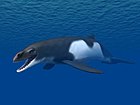Nannocetus
| Nannocetus Temporal range: Miocene,
| |
|---|---|
| Scientific classification | |
| Domain: | Eukaryota |
| Kingdom: | Animalia |
| Phylum: | Chordata |
| Class: | Mammalia |
| Order: | Artiodactyla |
| Infraorder: | Cetacea |
| Family: | Cetotheriidae |
| Subfamily: | †Herpetocetinae |
| Genus: | †Nannocetus Kellogg, 1929 |
| Species | |
|
†N. eremus Kellogg, 1929 (type) | |
Nannocetus is an extinct baleen whale belonging to the family Cetotheriidae.[1][2]
Description[edit]
Nannocetus is a diminutive mysticete measuring 13 feet (4.0 meters) long. It is characterized by the ventral orientation (in posterior view) of the postglenoid process; postglenoid process twisted medially (in ventral view) relative to the anteroposterior axis of the skull; equal projection of the ventral and dorsal lobes of the tympanic than the dorsal lobe; deeper notch separating the two lobes of the tympanic; reniform morphology of the tympanic in ventral view; lip of the tympanic slightly inflated; sub-rectilinear medial edge of the involucrum with a step in its anterior third; anterior process of the petrosal sub-triangular; thin crista transversa of the petrosal; and pars cochlearis hemispherical.[3]
Taxonomy and classification[edit]
The holotype is UCMP 26502. It was collected from the Late Miocene (Messinian) Towsley Formation of Humphreys, Los Angeles County, California.[4] It has been traditionally assigned to Cetotheriidae since its description, a classification that still stands and has been vindicated by recent cladistic analyses of 'cetothere' relationships.[5][6]
References[edit]
- ^ M. D. Uhen, R. E. Fordyce, and L. G. Barnes. 2008. Mysticeti. In C. M. Janis, K. M. Scott, and L. L. Jacobs (eds.), Evolution of Tertiary Mammals of North America II:607-628
- ^ L. G. Barnes. 1977. Outline of eastern North Pacific fossil cetacean assemblages. Systematic Zoology 25(4):321-343
- ^ V. Bouetel and C. Muizon. 2006. The anatomy and relationships of Piscobalaena nanna (Cetacea, Mysticeti), a Cetotheriidae s.s. from the early Pliocene of Peru. Geodiversitas 28(2):319-395
- ^ R. Kellogg. 1929. A new cetothere from southern California. University of California Publications in Geological Sciences 18(15):449-457
- ^ M. C. McKenna and S. K. Bell. 1997. Classification of Mammals Above the Species Level 1-640
- ^ M. Bisconti, O. Lambert, and M. Bosselaers. 2013. Taxonomic revision of Isocetus depauwi (Mammalia, Cetacea, Mysticeti) and the phylogenetic relationships of archaic 'cetothere' mysticetes. Palaeontology 56(1):95-127




